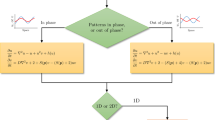Abstract
Spontaneous pattern formation may arise in biological systems as primary and secondary bifurcations to nonlinear parabolic partial differential equations describing chemical reaction-diffusion systems. Such Turing prepatterns have a specified geometry as long as D/R 2 (the diffusion coefficient of the morphogen D divided by the square of a characteristic length) is confined to a (usually) limited interval. As real biochemical systems like cleaving eggs or early embryos vary considerably in size, Turing prepatterns are unable to maintain a specified prepattern-geometry, unless D/R 2 is varied as well. We show, that actual biochemical control systems may vary D app/R2, where D app(k) is an apparent diffusion constant, dependent on enzyme regulated rate constants, and that such simple control systems allow Turing structures to adapt to size variations of at least a factor 103 (linearly), not only in large connected cell systems, but in single cells as well.
Similar content being viewed by others
References
Babloyantz, A.: Self-organization phenomena resulting from cell-cell contact. J. Theor. Biol. 68, 551–561 (1977)
Bateman, H.: Tables of integral transforms, vol. 1. New York Toronto London: McGraw-Hill 1954
Boiteux, A., Hess, B.: Spatial dissipative structures in yeast extracts. Ber. Bunsen-Ges. Phys. Chem. 84, 392–398 (1980)
Bunov, B., Kernevez, J.-P., Joly, G., Thomas, D.: Pattern formation by reaction-diffusion instabilities: Application to morphogenesis in Drosphila. J. Theor. Biol. 84, 629–649 (1980)
Cheung, W. Y.: Calmodulin plays a pivotal role in cellular regulation. Science 207, 19–27 (1980)
Gierer, A.: Generation of biological patterns and forms: some physical, mathematical, and logical aspects. Prog. Biophys. Mol. Biol. 37, 1–47 (1981)
Haken, H.: Synergetics. Berlin Heidelberg New York: Springer 1978
Hunding, A.: Dissipative structures in reaction-diffusion systems: Numerical determination of bifurcations in the sphere. J. Chem. Phys. 72, 5341–5248 (1980)
Hunding, A.: Possible prepatterns governing mitosis: The mechanism of spindle-free chromosome movement in Aulacantha scolymantha. J. Theor. Biol. 89, 353–385 (1981)
Hunding, A.: Morphogen prepatterns during mitosis and cytokinesis in flattened cells: Three dimensional Turing structures of reaction-diffusion systems in cylindrical coordinates. J. Theor. Biol. 114, 571–588 (1985)
Kauffman, S. A., Shymko, R. M., Trabert, K.: Control of sequential compartment formation in Drosophila. Science 199, 259–270 (1978)
Lacalli, T. L., Harrison, L. G.: The regulatory capacity of Turings model for morphogenesis, with application to slime moulds. J. Theor. Biol. 70, 273–295 (1978).
Levin, S. A., Segel, L. A.: Pattern generation in space and aspect. SIAM Rev. 27, 45–67 (1985)
Meinhardt, H.: Models of biological pattern formation. London New York: Academic Press 1982
Meinhardt, H.: Hierarchical inductions of cell states: A model for segmentation in Drosophila. J. Cell Sci. Suppl. 4, 357–381 (1986)
Nicolis, G., Prigogine, I.: Self-organization in nonequilibirium systems. New York London, Sydney Toronto: Wiley 1977
Othmer, H. G., Pate, E. E: Scale invariance in reaction-diffusion models of spatial pattern formation. Proc. Natl. Acad. Sci. USA 77, 4180–4184 (1980)
Selkov, E. E.: Self-oscillations in glycolysis. Eur. J. Biochem. 4 79–86 (1968)
Turing, A. M.: The chemical basis of morphogenesis. Philos. Trans. R. Soc. Lond., Ser. B. 237, 37–42 (1952)
Tyson, J. J.: A quantitative account of oscillations, bistability, and travelling waves in the Belousouv-Zhabotinsky reaction. In: Field R. J., Burger, M. (eds.) Oscillations and travelling waves in chemical systems, pp. 93–114. New York: Wiley 1985
Wolpert, L., Stein, W. D.: Positional information and pattern formation. In: Malacinski, G. M., Bryant, S. V. (eds.) Pattern formation, pp 3–21. New York: Macmillan 1984
Author information
Authors and Affiliations
Rights and permissions
About this article
Cite this article
Hunding, A., Graae Sørensen, P. Size adaptation of turing prepatterns. J. Math. Biology 26, 27–39 (1988). https://doi.org/10.1007/BF00280170
Received:
Revised:
Issue Date:
DOI: https://doi.org/10.1007/BF00280170




